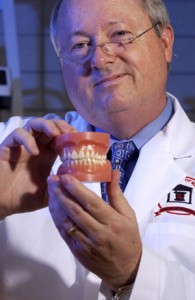
Michael A. Repka displays a transmucosal patch, placed just above the gumline (top center) of this set of false teeth. UM photo by Robert Jordan.
OXFORD, Miss. – An innovative delivery method for tetrahydrocannabinol, the main psychoactive constituent of Cannabis, is being developed at the University of Mississippi.
School of Pharmacy faculty members Michael A. Repka, Soumyajit Majumdar and Mahmoud A. ElSohly have developed a transmucosal THC patch to overcome problems related to taking the drug in pill form. The patch is administered above the gum line.
“The main issue with oral THC delivery is that the drug gets metabolized before it reaches the bloodstream, resulting in a lot of variability in the dosage patients receive,” said Repka, chair of pharmaceutics and director of the Pii Center for Pharmaceutical Technology. “That has been a longtime problem. Delivering through the oral mucosa gives better absorption with minimal variability. When it goes into the mucosa, it bypasses liver metabolism, allowing for a lower dosage of the drug than when delivered orally.”
The project began nearly seven years ago and stemmed from ElSohly’s previous research on a THC suppository. The concept was to develop amino acid prodrugs, or drug precursors, to make THC more hydrophilic, or water-soluble, which aids in absorption.
“We began with the same compounds that were used in the suppository,” said ElSohly, president of ElSohly Laboratories Inc., as well as professor of pharmaceutics and research professor in UM’s National Center for Natural Products Research. “However, we found that the absorption took too long in the transmucosa, so we modified the chemistry and made another set of compounds that have better bioavailability, better stability and a longer shelf life.”
The formulas were first screened in rabbits, then in pigs at the UM Medical Center. Two of the prodrugs stood out as candidates for further testing.
“Our findings indicate that the buccal film-prodrug combination produces significantly higher plasma drug concentrations,” said Majumdar, associate professor of pharmaceutics and associate director of the Pii Center.
“It looks like we have a successful product with good bioavailability and blood levels,” ElSohly said. “We have observed absorption for up to 10 hours.”
The patch is processed using hot-melt extrusion, a process that is used widely in the plastics industry and is coming into its own in pharmaceutical manufacturing because it produces products of uniform shape and density. Fast-dissolving films or tablets are often produced using this technology.
“There are a lot of advantages to using the hot-melt extrusion technology,” Repka said. “It’s a simple process in which the drug can be extruded into a film and die cut into desired sizes. It’s an innovative way to produce these patches.”
The investigators credit a National Institutes of Health Centers of Biomedical Research Excellence, or COBRE, grant for kick-starting the project.
“The COBRE funding provided the initial support to identify the promising new series of prodrugs and to undertake the preliminary in vitro and in vivo studies on some of the compounds,” Majumdar said. “Further work was supported by other grants received through (the National Institutes of Health) in collaboration with ElSohly Laboratories.”
COBRE grants are awarded by NIH’s National Institute of General Medical Sciences through its Institutional Development Award, or IDeA, program, which builds research capacities in states that historically have had low levels of NIH funding.
“This Institutional Development Award Center of Biomedical Research Excellence grant has enabled the University of Mississippi to successfully train and mentor developing investigators, build state-of-the-art research infrastructure and conduct exemplary research activities,” said Fred Taylor, an IDeA program official at NIH’s NIGMS. “In pursuing these goals of the IDeA program, the center is making an impact on biomedical research and health in Mississippi, the region and the nation.”
Continued investigation of the two prodrug candidates is expected to lead to testing in humans.
“I’m expecting even better results in humans,” Repka said. “We are looking into partnership opportunities that could give us the opportunity to begin these tests. I’m confident that the combination of hot-melt extrusion technology and the oral transmucosal route is a novelty in which many will be interested.”
Research reported in this release was supported by the NIH’s NIGMS IDeA program under award number P20GM104932. The content is solely the responsibility of the author and does not necessarily represent the official views of the NIH.